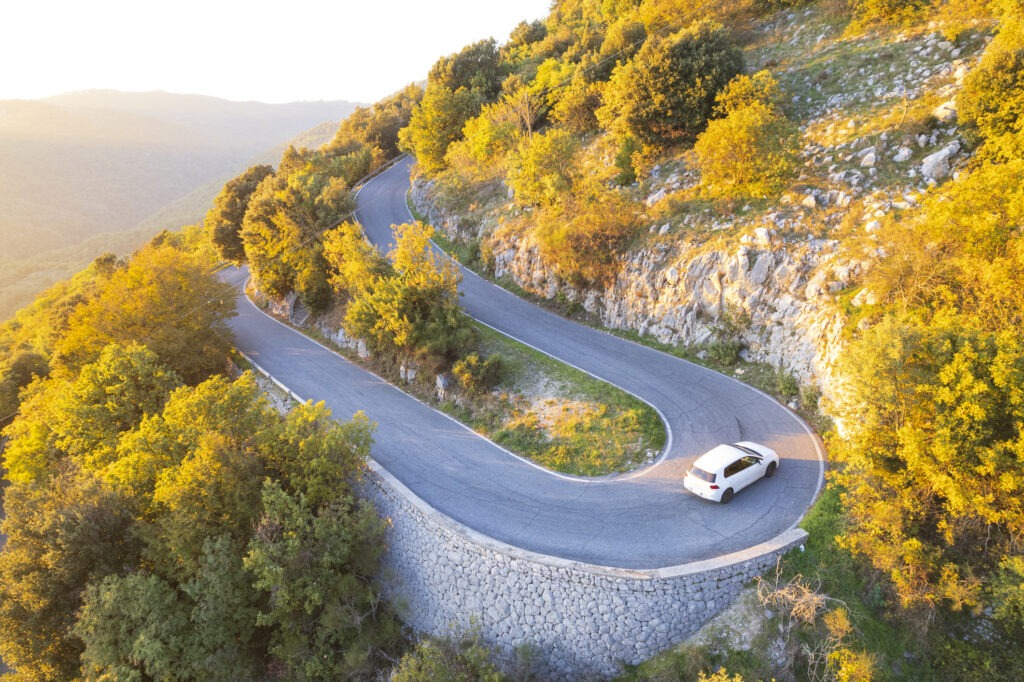Monthly Market Update: Decisive decline in European used-car demand
03 February 2025

Demand for used cars appears to be in decline across Europe, but how does this balance with supply? Autovista Group experts explore used-car market trends across Europe with Autovista24 editor Tom Geggus.
Major European used-car markets reported double-digit drops in demand during January. The sales-volume index (SVI) for two-to-four-year-old cars declined both month on month and year on year.
The SVI indicates that compared with December 2024, Spanish dealerships saw the greatest drop in demand, down 53.5%. This was followed by Germany (down 28.6%), Austria (27.2%), Italy (down 26.7%), Switzerland (down 24.1%), and the UK (down 19.7%).
This decline could be considered a seasonal effect, but these markets also saw the SVI fall compared to January 2024. The SVI dropped by 45% in Spain, the UK by 37.9%, and Germany by 26.6%. Italy followed, falling by 18.7%, Switzerland by 11.2% and Austria by 10.7%.
Many of these countries saw the SVI decline in previous months. However, January’s decline marks a more dramatic and consistent cross-market trend. The SVI was far from the only market indicator to flash red in January, however.
Supply also fell compared to December 2024 according to the active-market volume index (AMVI). Spain reported a year-on-year decline of 40.3%, Germany of 25.5%, and Italy of 24.1%. Used-car adverts declined by 13.1% in the UK, 12.3% in Switzerland, and 9.3% in Austria.
So, many of these markets are seeing supply and demand decline at relatively equal rates. This will mean no additional pressure on residual values (RVs), which are already forecast to decline across many European markets in the next three years.
Austria sees demand decline
The Austrian SVI continued to fall in January after declining in December. The number of sales observed sharply decreased by 27.2% compared to the previous month. The SVI indicated a year-on-year decline of 10.7%.
Meanwhile, the AMVI of two-to-four-year-old passenger cars remained stable in January compared to December. However, the supply volume of passenger cars in this age bracket slumped by 9.3% compared to the previous year.
‘At 65.8 days, the average amount of time needed to sell a used car decreased significantly in January,’ highlighted Robert Madas, Eurotax regional head of valuations, Austria and Switzerland. ‘This was around four days faster than in December.’
Diesel vehicles continued to be the fastest-selling powertrain, averaging 60.1 days. This was followed by full hybrids (HEVs) at 64.3 days, plug-in hybrids (PHEVs) at 63.8 days and petrol vehicles at 67.5 days. Battery-electric vehicles (BEVs) took the longest amount of time to sell at 85.7 days.
RVs of 36-month-old cars at 60,000km presented as a percentage of the original list price (%RV), increased to 48.3% on average in January. This was a 0.9 percentage point (pp) increase compared to December but a 4.7pp decrease year-on-year.
HEVs retained the greatest trade value in January at 52.2%, followed by petrol cars at 50.5%. Then came diesel models with 48.1% and PHEVs with 45.8%. BEVs again retained the lowest amount of value, at 41.6%.
In the coming years, %RVs are expected to decrease but at a slower pace. This is due to weakening demand and unwavering supply. By the end of 2025, %RVs are expected to decrease by 2.2%. In 2026, a slight year-on-year drop of 1.1% is expected.
SVI falls in Germany
‘Following a slight increase in December, Germany’s SVI showed a significant decrease in January,’ said Madas. ‘Month on month, this metric was down by 28.6%, year on year, there was a 26.6% drop.’
The AMVI of two-to-four-year-old passenger cars remained stable compared to December. The metric fell slightly by 2.6%. However, the supply volume of passenger cars in this age bracket dropped by 25.5% year on year.
The average number of days needed to sell a used car decreased to 58.7 days in January. BEVs sold the fastest, taking just 52.7 days. However, analysis has revealed that BEV adverts had significantly more price changes than other powertrains. BEVs were followed by PHEVs at 55.1 days. Then came diesel after 56.7 days, followed by petrol cars after 62.1 days and HEVs after 62.4 days.
Absolute RVs of 36-month-old cars at 60,000km remained stable in January. However, the %RV decreased due to a methodological effect. Higher new-car prices from 2022 are now being used to calculate the rate of RV retention.
These greater prices are resulting in lower %RVs. In January, models held an average %RV of 47.7%. Petrol cars led the market with a %RV of 49.5%. HEVs hit 49.4%, diesel models 48.6% and PHEVs 44.2%. BEVs retained the lowest amount of new-car list price of 37%.
As demand remains rather weak and supply persists, RVs can be expected to come under even more pressure. By the end of this year, %RVs are forecast to decrease, down 2.6% when compared with December 2024. Pressure will probably ease in 2026, and RVs will follow a declining trend of 1.4%.
Value decline expected in Italy
‘Last year, %RVs followed a downward trend in Italy,’ explained Marco Pasquetti, head of valuations, Autovista Group Italy. ‘In January, these values provided a surprise, as %RVs reached 50.2%, up from 48.7% in December 2024.’
However, this cannot be interpreted as a reversing trend. Instead, it is a symptom of seasonality, with a significant decline in values expected in the coming months. This year will present some significant challenges, which could drastically change the market scenario.
This includes the implementation of new CO2 emissions targets and competition with new manufacturers that have undergone consolidation. There may also be new policies designed to protect local production. However, %RVs on the Italian used-car market are currently expected to end the year down 3.7% year on year.
On average, used cars sold within 63.4 days, 1.6 days more than in December 2024, but 5.1 days fewer than a year ago. The fastest-selling powertrains were compressed natural gas (CNG) and liquid petroleum gas (LPG) at 42.9 and 44 days respectively.
HEVs also performed well, spending 59 days in stock. PHEVs and BEVs were well above the market average at 73.8 and 82.2 days respectively.
January’s fastest-selling models included the Dacia Sandero, the Dacia Duster and the Toyota Yaris Cross. Also making an appearance was the DR 4.0, a model marketed by local carmaker DR Automobiles. The brand is probably still little known outside Italy, but it holds a significant share of the local market.
Price resilience in Spain
Spain began 2025 in a good macroeconomic situation, with demand stimulated and optimism for much of the automotive sector. Accordingly, new-car sales grew in 2024, setting the country apart from other major European markets.
Last year’s figures were largely driven by Spain’s rental sector. This increased the supply of young used cars considerably and raised stock levels across all age groups. Young used cars sell more quickly due to higher demand. However, the oversupply also means greater pressure on transaction prices, which have fallen considerably.
‘Despite spending more time in stock, three-year-old used vehicles showed great price resilience,’ said Ana Azofra, Autovista Group head of valuations and insights, Spain.
The average price of a three-year-old car reached €19,621 in January, €266 more than in December. It took 80.5 days on average to sell these models. This was 8.2 days more than a month earlier and 6.5 days longer than January 2024.
The Renault Arkana sold in less than half this time at 37 days. This made it the fastest-selling model on the Spanish used-car market in January. It was followed by the Kia Sportage and the Toyota Yaris, a regular model in the ranking.
So, despite increasing stock days, January saw a very good RV performance. This came after a positive trend at the end of the year. The performance was also influenced by policies at the beginning of 2025. This lifted pressure on dealer networks to achieve targets and rebates.
Switzerland’s SVI decline
The SVI in Switzerland dropped significantly in January after only a slight decrease in December. The number of sales observed decreased by 24.1% compared to the previous month. Year-on-year, the SVI dropped by 11.2%.
‘Meanwhile, the AMVI for two-to-four-year-old passenger cars decreased slightly by 1.8% from December to January. Compared to 12 months ago, this indicator slumped by 12.3%,’ said Madas.
Influenced by constant supply but declining demand, RVs of 36-month-old cars at 60,000km dropped slightly in January. Last month, %RVs fell to 45.9% from 46.4% in December. However, the year-on-year drop was more severe, down 3.1pp from the values recorded 12 months ago.
HEVs retained the most value in January by far at 50.6%. Then came petrol cars (47.1%), diesel models (44.5%) and PHEVs with 43.5%. BEVs were once again the worst-performing powertrain. All-electric cars retained only 40.3% of their original list price after three years and 60,000km.
‘January saw two-to-four-year-old passenger cars sell slightly more quickly than in December. These vehicles spent 80.3 days in stock on average,’ Madas pointed out.
Diesel cars sold fastest at 76.2 days, followed by HEVs at 78.2 days and petrol models at 78.4 days. BEVs took 84.7 days, showing a significant year-on-year decrease of 7.4 days. Meanwhile, PHEVs needed the most time to sell at 93.5 days on average.
A trend of relatively stable supply and low demand will continue as various uncertainties shroud 2025. Therefore, %RVs are expected to decrease in the next years, but at a slower pace. By the end of 2025, %RVs are expected to decrease by 3.7%. In 2026, a slight year-on-year drop of 1.5% is expected.
No decline in supply for UK
The average three-year-old car retained 52.7% of its list price in the UK during January 2025. This was 1.7pp higher than in December 2024. However, it is important to remember that the ‘plate effect’ plays a part.
Nevertheless, comparing the RV development of last month with January 2024, there was only a 0.6 pp fall. A year earlier, there was a drop over 10pp, indicating that the used car market has become far more settled.
The SVI shows a fall in retail sales of 19.7% compared to December’s report. This covers the 30 days to 8 January, a period when big-ticket purchases tend to be less popular. However, looking back on 12 months ago reveals a more positive retail sales result.
‘As is often the case when the SVI shows a negative position, the AMVI shows an increased level of advertised models,’ explained Jayson Whittington, Glass’s chief editor, cars and leisure vehicles. ‘In January, there were 5.4% more cars up for sale on dealer forecourts.’
Reasonably strong wholesale activity was reported in January. However, auction hammer prices declined throughout the month and RVs are expected to follow suit. A balanced supply and demand dynamic is forecast this year.
This means significant RV drops, like the ones seen in recent years, are not expected. Values are currently expected to fall by approximately 3% by the end of this year.




